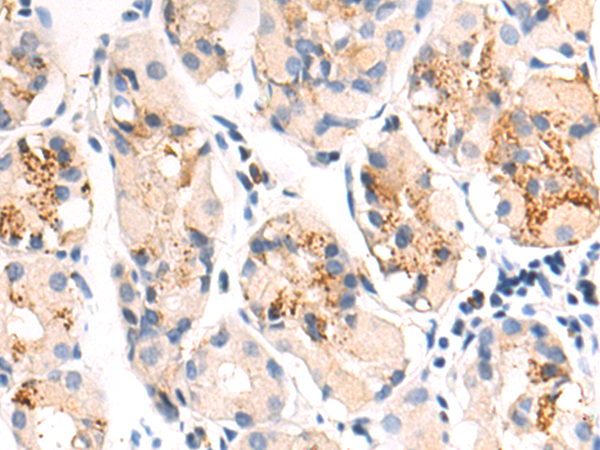

| WB | 咨询技术 | Human,Mouse,Rat |
| IF | 咨询技术 | Human,Mouse,Rat |
| IHC | 1/50-1/200 | Human,Mouse,Rat |
| ICC | 技术咨询 | Human,Mouse,Rat |
| FCM | 咨询技术 | Human,Mouse,Rat |
| Elisa | 1/2000-1/5000 | Human,Mouse,Rat |
| Aliases | OI6; OI12; PEDF; EPC-1; PIG35 |
| WB Predicted band size | 46 kDa |
| Host/Isotype | Rabbit IgG |
| Antibody Type | Primary antibody |
| Storage | Store at 4°C short term. Aliquot and store at -20°C long term. Avoid freeze/thaw cycles. |
| Species Reactivity | Human, Mouse |
| Immunogen | Fusion protein of human SERPINF1 |
| Formulation | Purified antibody in PBS with 0.05% sodium azide and 50% glycerol. |
+ +
以下是关于SERPINF1(PEDF)抗体的3篇参考文献,按文献名称、作者和摘要内容简要概括:
---
1. **文献名称**:*Pigment epithelium-derived factor (PEDF) in diabetic retinopathy: a protective role in the blood-retinal barrier*
**作者**:Dawson DW, et al.
**摘要**:本研究利用SERPINF1特异性抗体,通过免疫组化和Western blot分析糖尿病小鼠模型视网膜中PEDF的表达变化,发现PEDF通过抑制VEGF信号通路保护血-视网膜屏障,提示其作为糖尿病视网膜病变的治疗靶点。
2. **文献名称**:*SERPINF1 as a prognostic biomarker in osteosarcoma: correlation with tumor angiogenesis*
**作者**:Huegel J, et al.
**摘要**:通过SERPINF1抗体进行免疫组织化学分析,发现骨肉瘤组织中PEDF表达水平与微血管密度呈负相关,低表达PEDF的患者预后较差,表明其通过抑制肿瘤血管生成影响疾病进展。
3. **文献名称**:*Neuroprotective effects of PEDF in Alzheimer’s disease models: insights from antibody-based modulation*
**作者**:Sanchez A, et al.
**摘要**:研究使用SERPINF1抗体阻断PEDF功能,发现其加剧了阿尔茨海默病小鼠模型的神经元凋亡和淀粉样蛋白沉积,证实PEDF通过激活抗氧化通路发挥神经保护作用。
---
以上文献均聚焦SERPINF1抗体的实验应用,涵盖视网膜病变、肿瘤及神经退行性疾病领域,提供机制与临床关联性分析。
The SERPINF1 antibody is designed to target the SERPINF1 protein, also known as pigment epithelium-derived factor (PEDF), encoded by the SERPINF1 gene. PEDF belongs to the serine protease inhibitor (serpin) superfamily but lacks protease inhibitory activity. Instead, it is recognized for its multifunctional roles, including neurotrophic, anti-angiogenic, anti-tumorigenic, and anti-inflammatory properties. Structurally, PEDF is a secreted glycoprotein with a molecular weight of approximately 50 kDa, widely expressed in tissues such as the eye, liver, and adipose tissue.
SERPINF1 antibodies are critical tools in biomedical research for detecting and quantifying PEDF expression in various experimental models. They are used in techniques like Western blotting, immunohistochemistry (IHC), and ELISA to study PEDF's involvement in diseases such as cancer, diabetic retinopathy, and age-related macular degeneration (AMD). In cancer, PEDF’s anti-angiogenic function suppresses tumor growth, while in ocular diseases, its neuroprotective effects help preserve retinal integrity.
Commercial SERPINF1 antibodies are typically raised in hosts like rabbits or mice, available as monoclonal or polyclonal forms. Validation for specificity and cross-reactivity is essential, as PEDF shares structural motifs with other serpins. Research using these antibodies has advanced understanding of PEDF’s dual role in tissue homeostasis and pathology, highlighting its therapeutic potential. For instance, modulating PEDF levels is being explored for treating neurodegenerative disorders and ocular neovascularization.
×